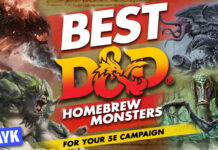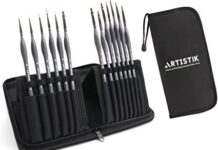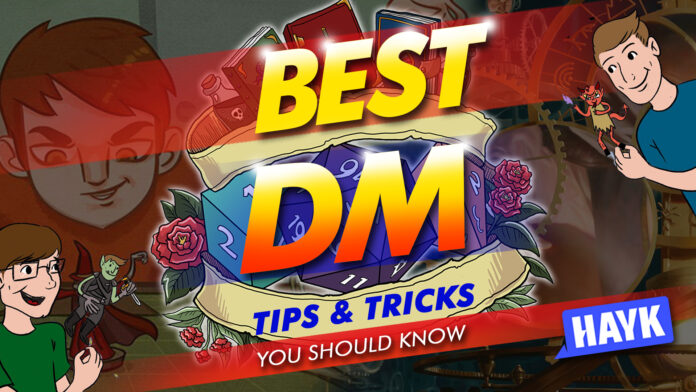
The life of a Dungeon Master is never easy. If you’re a DM, you need to manage everything from the start. Campaign creation, session scheduling, combat mechanics – these are some things that you should worry about. Thankfully, you can always find a handy collection of the best DM tips and tricks.
This article will get you started with a decent amount of DM tips. All of the discussed tips have been tested in multiple campaigns and sessions.
The Best DM Tips and Tricks Explored
Campaign Creation

Don’t Fall For the Worldbuilding Trap
Worldbuilding is an interesting process that can open up new possibilities in a campaign. Through a diligent worldbuilding process, the DM can create new locations and connect various plot threads to push the story forward. Worldbuilding also expands the campaign’s lore, adding flavor to players’ gameplay experience.
All good things side, worldbuilding has a bad side. It’s a trap waiting to snare DMs into unnecessary exposition and lore-dumping. If you want to avoid getting trapped by excessive worldbuilding, simply step back and focus on the essentials. Accept the fact that players barely remember archaic lore details. Majority of players don’t even remember NPC names at all!
Let your campaign sessions define the worldbuilding process. During the first session, just share basic lore information about the immediate surroundings. Next session, you can add rumors and extra story tidbits to spice up the campaign.
Use the Power of Story and Rumors
Storytelling is the creative glue that binds everything in your campaign together. While mechanical rules are still important, they are only secondary to a campaign’s thriving storyline. To ensure the smooth flow of your campaign’s story, you should examine it chapter by chapter. Do your best to connect a chapter to a BBEG’s key action or strategy. In this way, the players will feel the pressure of a rapidly changing world.
Rumors are excellent story triggers. A delicate rumor spouted by an NPC can become a strong lead for players to follow. Maybe that rumor can reveal the location of the BBEG’s most rutsted henchman. Or perhaps the rumor can be a red herring designed to plunge the players into a semi-deadly encounter.
Sprinkle the rumors all over your campaign map. If the party evades the rumors consistently, let them do some ‘rumor checks’ in specific areas like taverns or gathering halls. The players can also get rumors from satisfied merchants or nobles.
Create a Detailed Campaign Outline
While it’s easy to bake an idea about an exciting fantasy adventure, setting everything up is a different story. You might nail down the early part of the campaign, but you’d have a hard time envisioning the middle part or the end. This can lead to potential delays and disappointing half-measures.
To avoid throttling your campaign halfway, you must prepare an outline right from the beginning. Your outline should cover the important areas of the campaign such as Beginning, Middle, and End. Aside from these areas, you must include important NPCs and key locations. Consider your campaign outline as a script that must be followed.
Create a Unique BBEG
A campaign relies on the dynamic between the protagonists and antagonists. The campaign’s antagonists start with different goals, and they may work with each other. Even though multiple enemy leaders can make a campaign worthwhile, the BBEG (Big Bad Evil Guy) is the main star.
Having a unique BBEG in your campaign is a great way to keep your players interested. It’s easy to find any type of BBEG online. You can even retexture 5E’s iconic villains like Strahd Von Zarovich or Halaster Blackcloak. But making a unique BBEG? That requires serious work and dedication.
All terrifying BBEGs start out with a sense of motivation powered by a clever backstory. Such motivation can lead into concrete goals that players must strive against.
Do you need a list of custom goals for your BBEG? These are some options:
- Create an extradimensional real estate at the expense of the world’s safety
- Fuse hundreds of magic-sensitive individuals and attempt to make a ‘super creature’
- Spark a genocidal world conflict and install a puppet government
- Build a powerful machine that can turn a target civilization into a new race
- Summon avatars of selected deities and turn them against each other
- Destroy a hated kingdom by summoning dormant world-shattering beasts
Once you’ve set a goal for your BBEG, you should add personality quirks. These quirks will make your BBEG exciting yet relatable. Also, don’t forget to add a dash of humor in your BBEG’s selection of quirks.
Only Use Unfinished or Impartial Maps
Maps are important for any D&D campaign. A small map will help players see the environment of their observable area, leading to the discovery of essential locations. Despite the usefulness of maps, they can potentially limit the creative capabilities of any DM.
If you want to build a campaign within the boundaries of a big map, start the process by marking segments or partitions. You can write campaign details in the players’ starting area. Some details that you should focus on are location summaries, encounter triggers, scattered lore information, rumors, and casual job boards (like town bounties).
You don’t need to finish a map in one sitting. Sometimes, the desire to finish a map can lead to excuses like avoiding sessions, lore-dumping, and creating massive delays. Unfinished or impartial maps are better because they trigger creativity without overwhelming DMs or players.
It’s even more interesting if players get the opportunity to map out a specific area. The players just need to listen attentively to the DM’s description so they don’t miss any details.
Session Tools and Materials

Index Cards Are Handy Helpers
One item that can help you run a session is a pack of affordable index cards. The index cards will almost eliminate the need for consistent page-turning. You just need to prioritize which rules or campaign information should be written in the index cards.
These are some excellent suggestions:
- Combat mechanics
- Character abilities, modifiers, and class features
- Conditions
- Chosen monster stat blocks
- Lair actions
- Secret messages for players
- “X” symbols (flashed by players during uncomfortable situations)
- NPC information
- Magic items
The minor downside of using index cards is the prep time needed to transfer rules and information. But beyond that sacrifice of hard work, you’ll have an easier time DMing most sessions!
Anything Can Be A Mini
Miniatures help everyone visualize what’s happening in the table. Moving a miniature to a designated square is twice easier to explain than describing the process through plain words. While it’s easy to order miniatures nowadays, they will eventually put a dent to your bank account.
Well, if you want to save money, you just have to remember one thing – everything can be a miniature. You can use colored coins, plastic toy soldiers, key chain figures, plushies, and even bottle caps. Cardboard cutouts are also great alternatives.
Simplify Your VTT with Owlbear Rodeo
Because of the global pandemic, many physical campaigns had to stop and migrate into a digital atmosphere. Such unified transition gave way to the rise of VTTs or virtual tabletop platforms. The most popular VTT is Roll20, followed by Foundry and Tabletop Simulator. All of these programs have free and paid membership options.
Even though the popular VTTs are useful, they are somehow difficult to learn. One small alternative that you can try is Owlbear Rodeo. This web-based platform can do the basic functions of a VTT such as map uploading, token control, fog options, and labeling. Owlbear is 100% free and can be used for all tabletop RPGs.
Owlbear Rodeo is perfect for one-shots and hasty encounter setups. There are some limitations, of course. The program is cache-exclusive, so any changes done in a computer won’t appear in another device. Don’t worry – Owlbear is in constant development and will have new features later.
Online D&D Ideas are Treasures
In D&D, ideas are truly bulletproof. Nothing can stop a DM from using an old idea or a fantasy trope in a campaign. So, instead of reinventing D&D concepts, you can just do a quick online search and get ideas from strangers. D&D forums are great sources of ideas, and most of them are cool yet untested homebrew options.
Once you’ve found some cool D&D ideas, try to personalize them by adding your personal brand or ruling. Just make sure that you only use these ideas in your table and not for commercial purposes. Don’t forget to thank or credit the original author of the idea!
Aesthetic Materials Boost Player Morale
D&D is a higher form of traditional make-believe. You won’t actually encounter dragons or bugbears in real life. Despite this limitation, the mind makes everything real by evoking distinct emotions in a session. Through emotional manipulation (in a good way), the DM can create strong drama and heighten the stakes of combat.
One simple way to boost your players’ morale and keep them emotionally invested is to use aesthetic materials in the table. Some materials that you can use are custom potion bottles, D&D décor, miniatures, natural rock markers, costumes, dice jails, and terrain pieces.
D&D aesthetic materials have varying costs. Most of them are affordable while customized materials are pricey. If you have the knack for crafting, just make your own materials and add your signature style.
Handling Combat
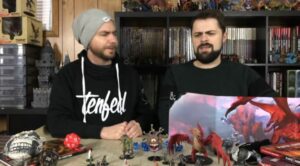
Use Basic Stat Blocks Then Modify Accordingly
Almost all D&D monsters have stat blocks. These stat blocks contain all mechanical information about specific monsters. Each stat block is like a mini-manual that will teach you how to command a monster in the battlefield. While stat blocks look strict with tons of words and numbers, they’re not set in stone.
Throughout your campaign, you’d find situations where the basic monster stat block won’t suffice. In that case, you must learn how to operate at the bare minimum. Rip a basic stat block from the Monster Manual (or any other source) and add or remove some abilities. You can turn a Bear stat block into a mini-boss by adding features like extra damage on hit, monster feats, legendary actions, and immunities.
Make sure that your monster modifications fit the lore of the campaign. You shouldn’t add a life-draining ray gun to a Bear if your campaign is low-magic medieval fantasy. This modification might ruin the experience for all players.
Also, boosting a monster’s health can turn the encounter into a battle of attrition. You can counter this by adding special functions as the monster’s health goes down. Perhaps the monster will lose more HP upon receiving continuous slashing or piercing damage. The monster can even go berserk before it succumbs to the finality of death.
Stat block adjustment is a balancing act. So, make it count for your players!
Challenge Your Players But Don’t Break Them
All players want a decent challenge, whether they deny it or not. Without a spark of challenge, players will get bored and distracted. But if players face constant challenge without breaks, they might grow weary and leave the campaign. As a DM, you must always find a middle ground.
You’re not running a campaign to win against the players. Rather, your duty is to tell a story and witness remarkable events driven by the dice and players’ imagination. You have the power to create balanced encounters or extremely difficult situations where sacrifices are needed.
So, challenge your players during encounters, but give them opportunities to escape or survive. This is an excellent way to build tension and invoke strong emotions.
Change Combat Rules Based on the Encounter
D&D 5E has a flexible set of combat rules that DMs can modify. Even though 5E’s combat rules are purely technical, they can still be changed depending on the current encounter. Some factors that you should consider are character level, players’ tactical skills, party synergy, magic items, important NPCs, monster behavior, and environment.
Action economy is the most malleable aspect that you can change in D&D. You can allow players to have multiple actions per turn to speed up combat. One downside is the increased lethality of encounters since monsters will have numerous actions as well. Changing action economy is a double-edged sword, but it will make encounters more meaningful.
Changing combat rules shouldn’t be a regular thing. In a campaign, you must only change general combat rules once or twice. Consistent rule-changing is burdensome for your players.
Make the Monsters Unpredictable
Many DMs make the common mistake of turning their monsters into immobile fodder. Such ‘fodder monsters’ end up having basic actions like attack, flee, and grovel. If you want to make dynamic campaign encounters, you should make monsters and enemies unpredictable.
Read each monster’s stat block diligently. Every monster has ability scores that can, more or less, dictate their behavior. A high INT monster will try to reason out with players and offer a bargain for escape. Consequently, a brutish high STR monster will resort to violence above all.
These are some extra ways to increase a monster’s unpredictability:
- Scattered helpful items that players didn’t notice
- Formation and pack tactics
- Trap usage
- A secondary or tertiary form
- Explosive death
Keith Ammann’s book, The Monsters Know What They’re Doing, is an essential tool that will help you make unpredictable monsters. The book also covers dangerous tactics influenced by a monster’s lore and tribal background.
Always Utilize Monster Lairs
One thing that’s commonly overlooked by DMs is a monster’s lair. The lair is an important modicum of control linked to a specific monster’s lore. If you can utilize a monster lair to its full extent, you can turn a ‘fodder monster’ into a deliverer of death. Monster lairs are excellent for BBEGs and mini-bosses, but small tribes can benefit from them as well.
To make a monster lair effective, you should describe it with natural traps and choke points. One good example is a Beholder’s lair. Since a Beholder is a solitary intelligent guardian, it probably erected some areas filled with magical traps. Drop some hints about these areas to confuse players and keep them on guard.
A monster lair’s structural style depends on the inhabitants. Some lairs are similar to abandoned temples and crypts, while others are just caves and plain dirty hovels. The common thing among numerous lair types is the sense of danger they can evoke.
Unique D&D Products to Make DMing Easier
Hexers RPG Dry-Erase Board

A dry-erase board is a useful item that can boost any DM’s creativity. Compared with online tools, dry-erase boards allow spontaneous sketching and tactile positioning. You can even prepare a quick battle terrain with sketch board and a couple of sharpie markers.
The best sketch board that you should have is Hexers RPG dry-erase board. This large board has two usable sides – square and hex. The square board side is great for measuring small distances, while the hex side is excellent for outdoor combat encounters. Since the board is foldable, it can be transported easily. Great for your next D&D RPG convention!
The Book of Holding – Journal with Grid Paper
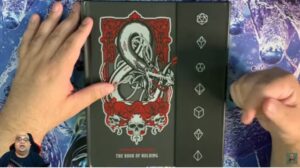
Do you want to own an official D&D journal with great collectible value? Forget about old notebooks and diaries! The item that you should have in your DM arsenal is D&D’s Book of Holding.
With 144 high-quality blank pages, the Book of Holding will let you jot many notes and campaign ideas. The Book of Holding also contains grid papers to help you design encounters and conceptual scenarios.
Aside from being a repository of campaign ideas, the Book of Holding can also be a stylish personal journal or diary. You may even send it as a gift to a dear friend or a special someone!
The Game Master’s Book of Random Encounters
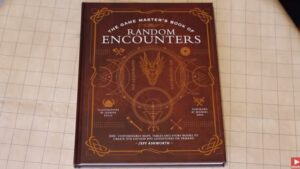
Are you tired of making and recycling encounters every time? In that case, you should check out the Game Master’s Book of Random Encounters by Jeff Ashworth. This massive book contains more than 500 encounters sorted into numerous categories. Aside from encounters and tables, the book has many detailed maps and random NPC names.
The Game Master’s Book of Random Encounters will cut many hours from your prep time. You no longer have to start an adventure from scratch. Plus, your players might even admire your ingenuity of preparing an encounter in less than 30 minutes.
Best D&D Mechanics to Make Your Campaign Sessions Worthwhile
Advanced Crafting
Crafting is a natural part of D&D or any RPG. Many players love crafting because it gives them a form of control and an opportunity to save money on potions. Despite the usefulness of a crafting system, other players forget about it over time. They prefer to slay monsters and find powerful magic items that can turn the tide.
Instead of using generic crafting rules, you can try an advanced crafting system. This system will compel your players to gather exotic reagents and materials. The payoff comes in the form of valuable potions that can grant helpful effects like strong healing, revival, combat damage boost, spell potency, and transformation.
Advanced crafting is not just limited to potions. The system can be used to build powerful artifacts or relics. You can search for a list of crafted items online and add your own modifications. Some digital stores even provide affordable PDFs filled with potions, strange foods, and collectable reagents.
Advanced Weapon Augmentation
Just like crafting, weapon augmentation is a common part of RPGs. However, this system isn’t fully explored in D&D 5E. You need extra sourcebooks to implement augmentation mechanics, and the ideas are few and far between.
Once you managed to pull off an advanced weapon augmentation system for your campaign, players will naturally become stronger. They will even develop a strong bond for their weapons, and they might pay more gold to unlock additional augments.
Damage improvement is the common benefit of weapon augmentation. This is also a basic process that requires the expertise of a crafter NPC. Next to damage improvement is the subject of aesthetics. D&D players love to collect cool weapons with a unique style or color scheme. It’s even better if players can get a commissioned image of their newly augmented weapons.
Artificers are the best classes that can take augmentation projects. It’s not surprising if an artificer player gets moderately wealthy after accomplishing numerous projects throughout the adventure!
Custom Spell Creation
The next complicated yet interesting system that you should try is custom spell creation. D&D 5E has an exhaustive list of powerful spells that players can use. Sometimes, however, these spells fail to reach their intended goals and they seem under-powered or underutilized. The best answer for this dilemma is the opportunity to craft custom spells.
To use the custom spell creation system, you need to work from scratch. Create new conditions governed by the spell schools to help players with their spellcrafting journey. You must also prepare a list of spell combinations ahead of time.
Custom spell creation is exciting but requires diligent balance. Just accept the fact that your players might gain the opportunity to create encounter-breaking spells for the sake of victory. This is one of the consequences of a free-form spellcrafting system.
Progressive Pet System
Pet-collecting is an optional mechanic in D&D. Between roleplaying and killing bad guys, there’s little time left for collecting or raising pets. Still, many players love to collect pets and maintain some sort of an exclusive habitat.
The progressive pet system is the dream mechanic for all D&D pet lovers. This system involves the act of taming and raising pets. The pets can even level up and gain new feats over time. While this pet system sounds like extra work for DMs, it can spice up gameplay especially downtime activities.
Hireling System
As the players become wealthy, they will find new options to procure resources and expand their influence further. Instead of doing the hard work, players can just hire people to do their bidding. The Dungeon Master’s Guide covers the basic aspects of recruiting and hiring, but it still lacks a decent workable system.
The hireling system is a strong plug-and-play option that can scale up with the players’ levels. To run this system, you just need a list of NPCs with decent stat blocks. The hiring costs of these NPCs depend on their abilities, task specialties, and skills. You can also link these hirelings with prominent D&D factions like the Zhentarim or Lord’s Alliance.
The common tasks for hirelings are resource gathering, investigation, construction, assassination (costly!), conflict instigation, and dungeoneering. As long as there’s coin, hirelings will always remain with the players.
Dinosaur Racing
Dinosaur racing is a fun system implemented by Tomb of Annihilation. As the name suggests, players will get the chance to buy dinosaurs and ride them for exclusive races. Dino racing is a laid-back system that can build rapport among players and prominent NPCs.
Betting is an exciting part of dino racing. If players don’t want to race, they can just bet on popular dinosaurs and win a few gold coins. A lucky player can even grind the betting aspect and become rich in just one or two sessions.
Kingdom Management
Managing an entire kingdom is difficult, but it comes with natural perks like wealth, power, and exotic weaponry access. Not all campaigns have a kingdom management aspect because the story naturally ends with the death of the BBEG. In a way, kingdom management works like endgame content.
There are some downloadable kingdom management systems nowadays, but the best option comes from Pathfinder: Kingmaker. This system can be converted easily to 5E, and it also offers chances to procure magic items through honest rule alone. Using the system is easy because of multiple phases that resemble an in-game month. Dice checks are still included, and they determine the effectiveness of the players’ collective rule.
Naval Combat
An adventure in the high seas won’t be complete without naval combat. In naval combat, players must work together and deal with multiple problems at the same time. Boarding pirates will pump up the action, while the waves will keep everything rocky – motion sickness guaranteed. Naval combat is also a test for the DM since many details are running in the background.
Ghosts of Saltmarsh has a detailed guide on running a naval encounter. You can just use the adventure’s naval combat system and add extra rules along the way. Some rules that you should consider are cannon ballistics, swimming checks, mast fights, and ship damage management.
Large-Scale Combat
Try to envision the Battle of Middle-Earth. Now, try to envision that same battle in your campaign. You might feel overwhelmed because of the number of soldiers and players involved. Large-scale combat requires practice and careful planning, but it’s a rewarding system that can turn the odds in players’ favor.
Categorization is your most powerful tool in mass combat. You don’t need to resolve fights one by one or group by group. Rather, you must divide the theater of conflict into segments or regiments. Each segment must contain the appropriate number of belligerents, siege weapons, beasts of war, and leading players. Clashing segments can be resolved by a couple of checks, and normal combat will only take place among players and important enemies.
D&D forums have lots of resources about large-scale combat rules. You can copy these rules and create variations based on your campaign’s upcoming mass combat.
Gladiator Arena
A gladiator system is a great way for players to amass wealth, honor, and influence. Of course, there’s a big chance of dying but the chance of acquiring treasure is tempting enough for many players. You don’t need fancy rules to run a gladiator arena – the Monster Manual is more than enough.
To start your arena, simply choose a prominent NPC and lay down the stakes. Choose the environment and the monster participants. You should also add other NPCs with strong reasons and motives. Once everything is ready, schedule the fights and watch the mayhem unfold!
Spelljamming
A forgotten system from the old days of AD&D, spelljamming tackles the concept of extraplanar travel. This system is best for high-level players because leaving a plane (for a long time) requires tremendous wealth and a spacefaring ship called smalljammer. The term spelljammer refers to the massive sentient ship that crosses the infinite planes. There’s only one spelljammer, but smalljammers are many.
Running a spelljamming system is almost the same as naval combat albeit deadlier. Powerful, hungry monsters lurk in the darkness of space, and there’s always a chance to encounter the sinister Mindflayers (icky squid-like brain-eater enslavers).
Aside from the constant chance of death, spelljamming players will suffer the effects of time dilation. Upon returning home (if they can return), PCs might learn the sad truth that more than a century passed in their plane. This can lead to drama, pain, and grieving – in exchange of powerful artifacts, notoriety, and possible friends from other realms.
Tips and Tricks for DMs – FAQ
How many players are needed for a D&D campaign?
Answer: Theoretically, you can add as many players as you can effectively manage. However, the standard, manageable table size is four. In a four-player table, you don’t have to track excessive details and lots of actions. When it comes to encounter challenge, a four-player party still has a great chance of winning as long as everyone is focused and committed to the battle.
Should I always read the DMG and PHB to become a great DM?
Answer: Knowledge of the rules, lore, and terminology is essential for becoming a great DM. You can read the core D&D books as often as you want, but hands-on experience is your best bet. Just start DMing and you’d be a step closer to becoming a remarkable, Level 20 DM.
What is the best virtual tabletop tool for a DM?
Answer: It’s difficult to pinpoint the best VTT tool but the most popular option right now is Roll20. This VTT or platform has many limitations, but the ease of access is undeniable. Roll20 also has better branding compared to other systems like Foundry and Shard Tabletop.
Should a DM be a great player first before running a campaign?
Answer: You don’t need to be an expert player before becoming a DM. Anyone can start DMing, but only a few DMs can ever finish a campaign. Being an experienced player helps a lot, though. Through experience, you’d know how to design proper encounters with real valuable and useful rewards.
What qualities separate a beginner DM from a veteran?
Answer: Some noticeable qualities between a beginner DM and a veteran are consistency, expertise (not the Rogue Expertise), and professionalism. These soft skills require time to develop, and they can even help anyone succeed outside D&D.
Conclusion
Knowing the popular D&D tips and tricks is just one part of your DMing journey. You still need to work hard in building your campaign and running each session. At the very least, the tips discussed in this article will help you face the challenges that all DMs must face.
Do you have some extra D&D tricks to share? Tell us in the comments – we’d love to hear them!

